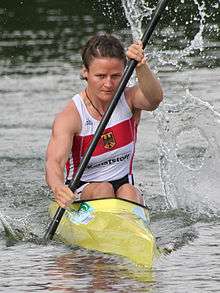Sprint kayak
Sprint kayak is a sport held on calm water. The paddler is seated, facing forward, and uses a double-bladed paddle pulling the blade through the water on alternate sides to propel the boat forward. Kayak sprint has been in every summer olympics since it debuted at the 1936 Summer Olympics.[1] Racing is governed by the International Canoe Federation.

History and design
Boats may have one rudder which must be under the hull of the boat. The rudder is controlled by the feet of the paddler (the foremost paddler in multi–person designs). The boat to be designed as to be a sit-in, as opposed to a sit-on surf ski.[2]
| Boats | K1 | K2 | K4 |
|---|---|---|---|
| Max. length in cm | 520 | 650 | 1100 |
| Min. weight in kg | 12 | 18 | 30 |
Crews or individuals race over 200m, 500m, 1000m or 5000m with the winning boat being the first to cross the finish line.
In competition the number of paddlers within a boat is indicated by a figure besides the type of boat; K1 signifies an individual kayak race, K2 pairs, and K4 four-person crews.
A K-3 kayak has been developed in South Africa for use in the Fish River Canoe Marathon.[3]
Modern sprint kayaks are generally made of lightweight composite materials such as carbon fiber and fiberglass; wood was previously used on older kayaks along with steel for some sections of the boat (i.e. the rudder). They are narrow, extremely unstable, and expensive. Due to this, they are not intended to be used in anything other than flatwater courses - they can capsize and/or be dragged underwater in moderate waves. The beam of a flatwater boat is typically barely wider than the hips of its paddlers and require the paddler to bend their legs in the boat, allowing for a long and narrow shape to reduce drag.
Canoe sprint kayaks are similar to sprint canoes, with both styles of boat usually at the same club or with the same team.
Paddles used for sprint boats are made out of carbon fiber and/or fiberglass. At the discretion of the paddler, the paddle may be angled to fit with the paddler's stroke. In addition, wing tip paddles, with the upper cusp of the paddle angled to form a cup (like cupping one's hand to paddle water) are often used to assist with speed increases and control in turns and drag while maintaining balance.
References
- "Canoe Sprint". International Canoe Federation. Archived from the original on 8 October 2010. Retrieved 18 July 2014.
- "Rules for Canoe Sprint" (PDF). ICF. Retrieved 22 July 2014.
- "K3 world record for Fish Canoe Marathon". Retrieved 18 July 2014.